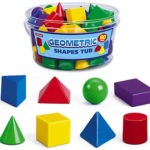Geometric Solid Shapes
We might all agree that young children begin to develop geometric concepts when they are able to identify simple shapes, not simply by memorizing the words of the shapes but by recognizing the attributes of a shape by its characteristics (a triangle has 3 sides- and is therefore, by definition a Triangle).
Solid shapes are a little bit harder and slightly more advanced in terms of defining attributes. When a circle is 2 dimensional, it is a circle. When it is 3 dimensional, it is a sphere. This bucket of Geometric Solid Shapes supports the young child’s emerging concepts of 3-dimensional shapes. They can be sorted, classified, and counted based on color, shape, size or attribute. They might seem too advanced for the smaller children, but I guarantee, that some of your kids are ready for this manipulative.

We use these shapes in the classroom but they are a bit bigger. We use them to get our students to think about why they can\’t stack certain shapes. We then get into a discussion about the shapes attributes.
Evelyn
Exactly the manipulative Ive been looking for – small enough for little hands, enough of them and color varieties for endless possibilities in comparison, classification, pattering, building etc
I find children like these shapes but they struggle more with them. I believe using them as manipulatives would help them feel more comfortable.
The only thing that worries me is that sometimes the children prefer to explore small shapes/pieces they can hold but they cannot have because it is a choking hazard.
I believe this would be an interesting lesson to offer to my Toddler class. An introduction to the mystery of dimension by the touch and feel of the shapes. Sparking their interest to think geometrically.